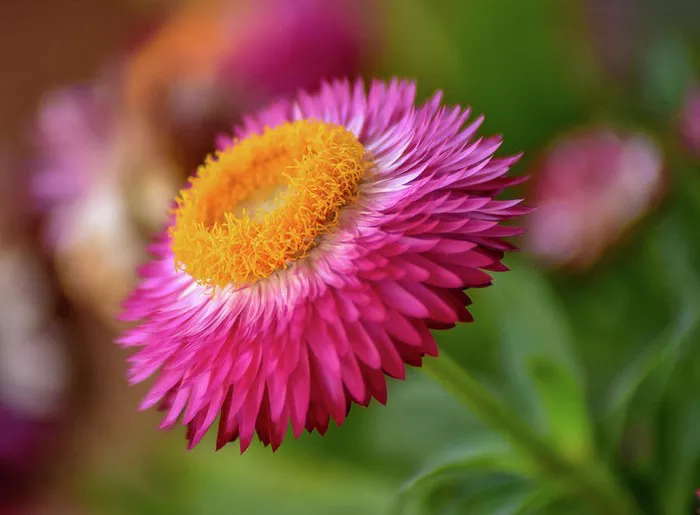Strawflowers, with their vibrant colors and papery petals, are a favorite among gardeners for their unique appearance and versatility in floral arrangements. Known scientifically as Xerochrysum bracteatum or Helichrysum bracteatum, these flowers are native to Australia but have gained popularity worldwide due to their long-lasting blooms and suitability for various climates. For those cultivating these beauties, understanding their blooming timeline is crucial for planning and enjoying a successful growing season.
Cultivation Requirements
Before delving into the specifics of their blooming period, it’s essential to understand the optimal conditions for growing healthy strawflowers. These plants thrive in full sun and well-drained soil with good air circulation. They are relatively low-maintenance once established but benefit from regular watering during dry spells, especially in hotter climates.
Germination and Seedling Stage
The journey of a strawflower begins with germination, a process triggered by adequate moisture and warmth. Typically, strawflower seeds germinate within 7 to 14 days when sown directly into the garden soil after the last frost date has passed. For early blooms or in colder climates, starting seeds indoors 6 to 8 weeks before the last frost can expedite the process.
Once germinated, the seeds develop into seedlings characterized by their slender, elongated leaves. During this stage, maintaining consistent moisture levels without overwatering is crucial to prevent damping-off and ensure healthy growth.
Vegetative Growth Phase
After the seedling stage, strawflowers enter a vegetative growth phase where they focus on building robust foliage and establishing a strong root system. This phase is crucial for the plant’s overall health and resilience. Adequate spacing between plants (typically 12 to 18 inches apart) allows for optimal air circulation, reducing the risk of fungal diseases.
Throughout this phase, regular fertilization with a balanced, water-soluble fertilizer can promote vigorous growth. Monitoring for pests such as aphids and caterpillars is also essential, as these can damage foliage and delay flowering if left unchecked.
Initiation of Flower Buds
The transition from vegetative growth to flowering in strawflowers is influenced by several factors, including day length and environmental conditions. Generally, strawflowers are classified as day-neutral plants, meaning their flowering initiation is not solely dependent on day length but rather on overall plant maturity and environmental cues.
Typically, strawflowers begin to form flower buds 8 to 10 weeks after germination under optimal growing conditions. The development of flower buds marks the imminent onset of blooming, a much-awaited transformation for gardeners anticipating a colorful display.
Blooming Timeline
The blooming period of strawflowers can vary based on cultivar, climate, and growing conditions. On average, once flower buds have formed, it takes approximately 6 to 8 weeks for the first blooms to appear. During this time, monitoring soil moisture and providing consistent care is crucial to support healthy flower development.
The duration of individual blooms can also vary, with each flower head maintaining its vibrant appearance for several weeks. Deadheading spent blooms promptly encourages continuous flowering throughout the growing season, prolonging the display of these charming flowers.
See Also: How Long Do Forsythia Flowers Last?
Factors Influencing Blooming Time
Several key factors influence the timing and duration of blooming in strawflowers:
Temperature: Optimal temperatures range between 65°F to 75°F (18°C to 24°C) during the day and slightly cooler at night. Extreme heat or cold can delay blooming or shorten the duration of individual flowers.
Light: While strawflowers are not strictly day-length sensitive, they do require full sun (at least 6 to 8 hours of direct sunlight daily) for robust growth and prolific blooming.
Nutrition: Adequate soil fertility, supplemented by periodic fertilization, supports healthy growth and abundant flowering. Avoid excessive nitrogen, as it can promote foliage growth at the expense of flowers.
Watering: Consistent moisture is crucial, particularly during periods of drought or high temperatures. However, soggy soil can lead to root rot and hinder blooming, emphasizing the importance of well-drained soil.
Pest and Disease Management: Vigilance against common pests and diseases such as aphids, spider mites, and powdery mildew is essential to prevent damage that can affect blooming and overall plant health.
Extending the Blooming Season
Gardeners can employ various techniques to extend the blooming season of strawflowers:
Successive Planting: Sowing seeds at intervals of 2 to 3 weeks ensures a continuous supply of fresh blooms throughout the season.
Deadheading: Removing spent blooms encourages the plant to redirect energy into producing new flowers rather than setting seeds prematurely.
Fertilization: Applying a bloom-boosting fertilizer high in phosphorus can stimulate additional flower production.
Mulching: A layer of organic mulch helps retain soil moisture, regulates soil temperature, and suppresses weeds, supporting prolonged blooming.
Conclusion
In conclusion, the blooming timeline of strawflowers is influenced by various factors, from germination and vegetative growth to the initiation of flower buds and the eventual display of vibrant blooms. Understanding these stages allows gardeners to cultivate healthy plants and anticipate a colorful and prolonged flowering season.
By providing optimal growing conditions—adequate sunlight, well-drained soil, proper watering, and vigilant pest management—gardeners can enjoy the beauty and versatility of strawflowers from early summer well into the fall months. Whether used in fresh floral arrangements, dried for crafts, or simply admired in the garden, these charming flowers continue to captivate with their enduring appeal and papery petals.


